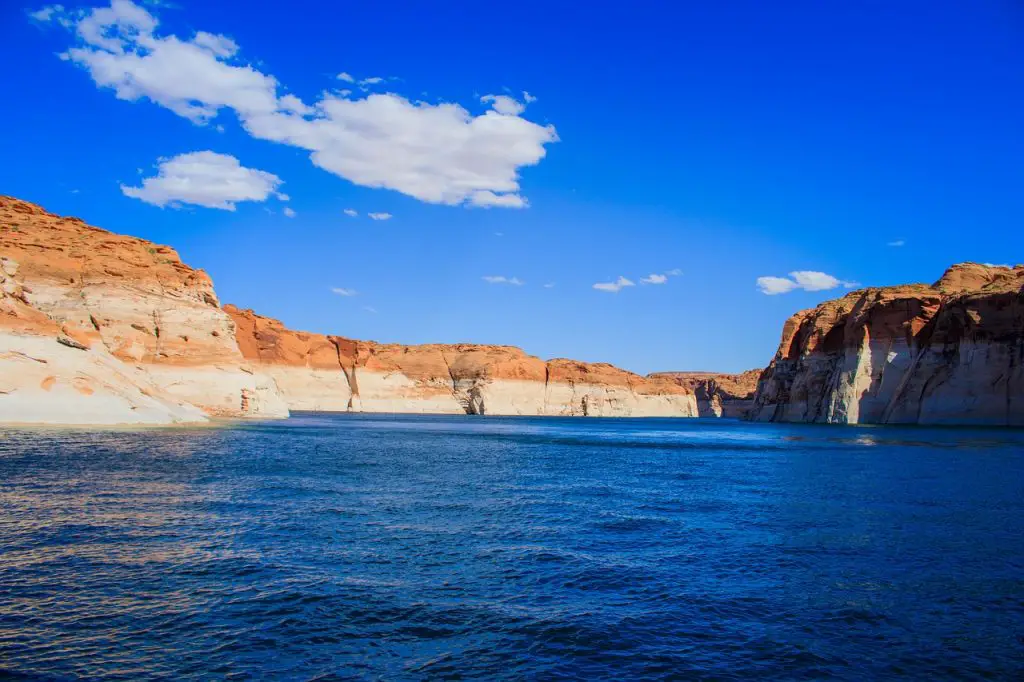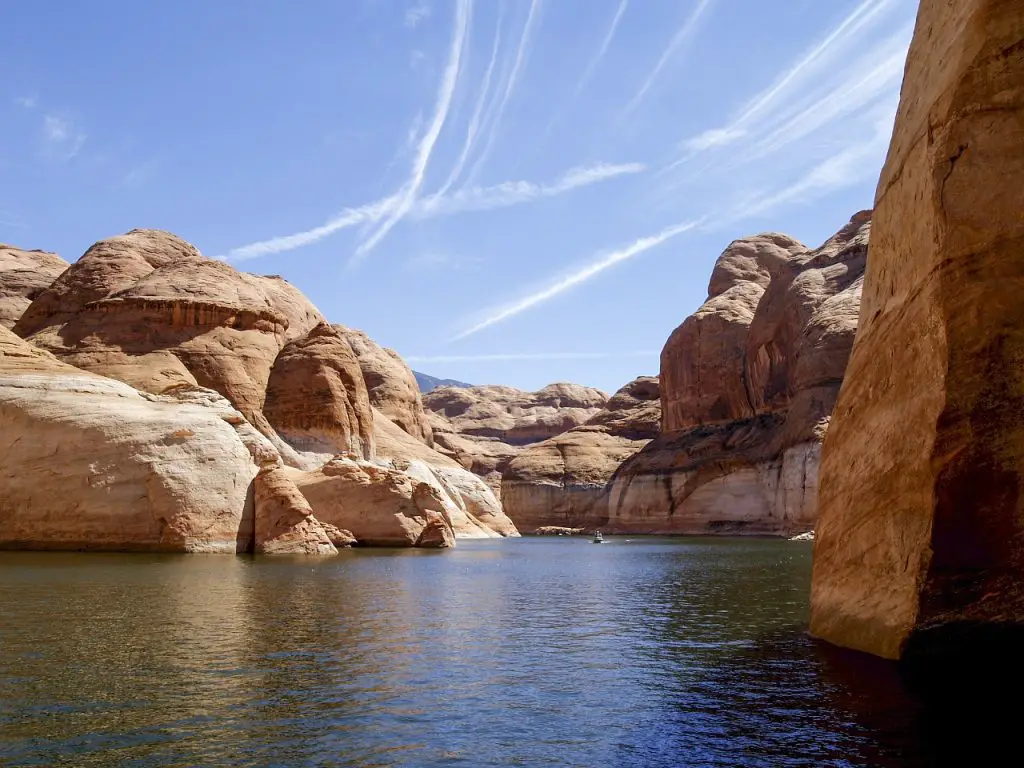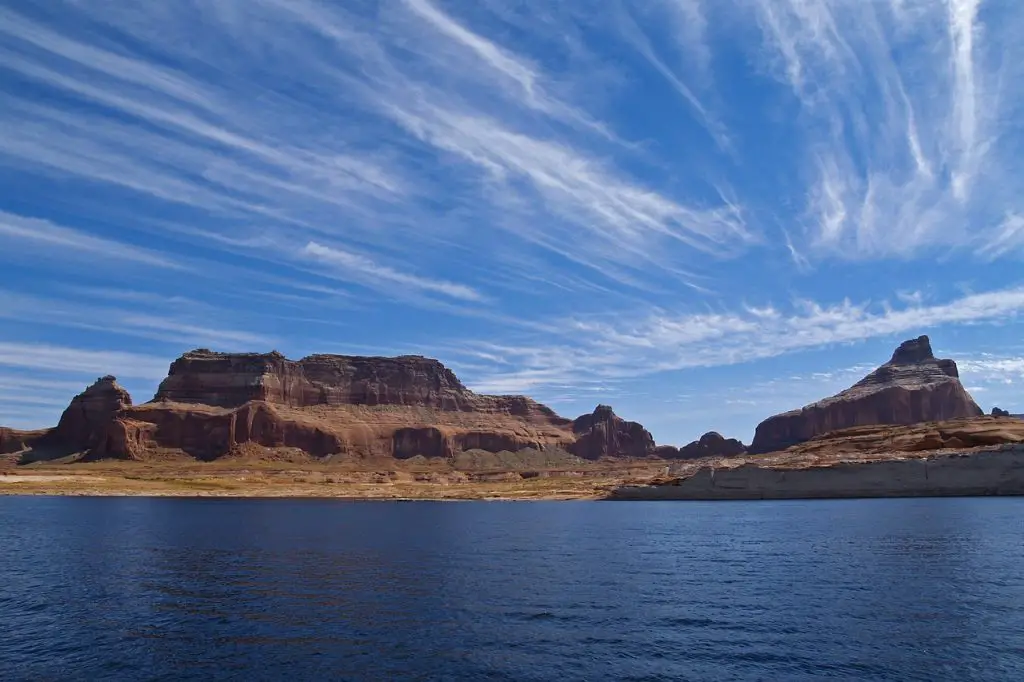Arizona, predominantly known for its deserts and the Grand Canyon, is also home to an array of beautiful lakes that contribute significantly to the state’s rich biodiversity and recreational offerings. With more than a hundred significant bodies of water, the question of ‘how many lakes in Arizona?’ showcases the diverse and often surprising elements of the state’s geography.

In Arizona, the majesty of the desert landscapes often overshadows the state’s aquatic resources. Yet, Arizona’s lakes play a crucial role in the environmental ecosystem, providing necessary water supply, shaping local climate, and offering recreational spaces. The lakes’ formation, both naturally occurring and man-made, adds another fascinating layer to Arizona’s diverse landscape.
The Role of Lakes in Arizona
Arizona’s lakes serve many purposes. Primarily, they are a significant source of water supply. Given Arizona’s arid climate, lakes and reservoirs act as lifelines, supplying water to both urban centers and agricultural regions. Lakes also play a significant role in shaping the local climate. They act as a moderating influence, reducing temperature extremes and providing a habitat for a variety of wildlife species.
In addition to their practical and environmental roles, lakes in Arizona are significant recreational destinations. Arizona’s lakes provide spaces for boating, fishing, bird-watching, and hiking, attracting both local residents and tourists. Lakes like Lake Havasu and Lake Powell are well-known for their scenic beauty and recreational facilities.
Formation of Lakes in Arizona
Arizona’s lakes have formed through a combination of natural processes and human intervention. The natural lakes in Arizona, although relatively rare, are mostly remnants of the Ice Age, created by the movement of glaciers. Meanwhile, oxbow lakes, formed by river erosion and deposition, can also be found in the state.
However, many of Arizona’s lakes are man-made, created as a result of damming rivers for water storage and hydroelectric power. These reservoirs are often expansive and play a critical role in the water supply. The Hoover Dam on the Colorado River, for example, has created one of the largest reservoirs in the United States, Lake Mead.

Classifying Lakes in Arizona
Arizona’s lakes can be classified in multiple ways: by size, source, and usage. By size, Arizona’s lakes can be categorized as large, medium, or small. For example, Lake Powell, created by the Glen Canyon Dam, is a large lake, while Parker Canyon Lake would be considered small in comparison.
Lakes in Arizona can also be categorized based on their origin: natural or man-made. Natural lakes, as previously mentioned, are primarily glacial or oxbow lakes. Most of Arizona’s lakes, however, are man-made, typically resulting from dam projects.
Finally, Arizona’s lakes can be categorized by their primary usage. Some lakes serve primarily as reservoirs for water storage and power generation, such as Lake Mead and Lake Powell. Others are primarily used for recreational purposes, such as Lake Havasu and Saguaro Lake. Still others, like the Cibola National Wildlife Refuge, are protected habitats for wildlife.
Overview of Arizona’s Notable Lakes
Lake Havasu is one of Arizona’s most famous lakes, known for its recreational opportunities. It’s a popular destination for boating, fishing, and swimming. The lake is also home to the historic London Bridge, relocated from England in the late 1960s.
Lake Mead, created by the Hoover Dam, is one of the largest man-made lakes in the world. It serves as a critical water supply for several states and provides opportunities for boating, fishing, and wildlife viewing.
Lake Powell, another large reservoir, offers stunning red rock scenery along with ample recreational activities. Its numerous side canyons are popular for exploration by boat.
Roosevelt Lake is a popular fishing destination in Arizona, known for its largemouth bass population. It’s also a significant water storage reservoir, supplying water to the Phoenix metro area.
Saguaro Lake, nestled in the rugged landscape of the Tonto National Forest, offers scenic beauty and a variety of recreational opportunities. It’s a popular spot for boating, fishing, hiking, and wildlife viewing.
Lesser-Known Lakes of Arizona
While Arizona is well known for its larger, more popular lakes, it also hosts several lesser-known lakes that offer unique experiences. Blue Ridge Reservoir, for instance, is a picturesque spot tucked away in the Coconino National Forest. It’s a narrow, winding lake that’s perfect for kayaking and fishing, offering a tranquil escape from bustling city life.
Alamo Lake, situated in the Bill Williams River Valley, is one of Arizona’s best bass fishing lakes. Remote and often quiet, Alamo Lake State Park is an ideal destination for those seeking a rustic and peaceful outdoor adventure.

Lyman Lake State Park, located in northeastern Arizona, is another gem. This lake is one of the few in the region where there are no size restrictions on boats, making it a popular spot for water skiing and fishing.
White Horse Lake is a serene mountain lake located in the Kaibab National Forest. This lake is a favorite among anglers, especially those interested in rainbow trout.
Parker Canyon Lake, nestled in the rolling grasslands of southeastern Arizona, offers fishing, bird watching, hiking, and a variety of other outdoor activities.
Recreational Activities in Arizona Lakes
Arizona’s lakes offer a wide array of recreational activities. Anglers will find a variety of fish species across the state’s lakes, including largemouth bass, rainbow trout, and catfish. The Arizona Game and Fish Department provides extensive resources for those interested in fishing, including stocking schedules, fishing reports, and guides to the various fish species found in the state.
Boating is another popular activity, with many lakes offering boat rentals and marinas. Water sports such as water skiing, jet skiing, and paddleboarding are also common on larger lakes like Lake Havasu and Lake Powell.
Birdwatchers and wildlife enthusiasts will find a wealth of opportunities in and around Arizona’s lakes. Species such as bald eagles, osprey, herons, and a variety of waterfowl can often be spotted near the water.
Environmental Challenges Facing Arizona’s Lakes
While Arizona’s lakes provide significant benefits, they also face numerous environmental challenges. Climate change is a major concern, as increased temperatures and changes in precipitation patterns may impact water levels and lake health. Arizona’s Climate Change Action Plan discusses these concerns and outlines steps to mitigate these impacts.
Pollution is another issue facing Arizona’s lakes. Runoff from urban areas, agriculture, and mining can carry pollutants into the lakes, negatively affecting water quality and wildlife. Various organizations, like the Arizona Department of Environmental Quality, work to monitor and improve water quality across the state.
Conservation efforts in Arizona aim to preserve and protect the state’s lakes for future generations. These efforts involve managing water usage, protecting habitats, and educating the public about the importance of water conservation.
Arizona Lakes and Local Communities
Lakes in Arizona significantly impact local communities, contributing to the local economy and shaping the area’s cultural and historical heritage. Lakes bring in tourism revenue through recreational activities like fishing, boating, and camping. They also provide water for irrigation, supporting local agriculture.
For Indigenous communities in Arizona, many lakes hold cultural and historical significance. For example, the Hopi Tribe views springs and bodies of water as sacred places. Efforts to protect and respect these cultural values play a critical role in managing Arizona’s lakes.
How to Enjoy Arizona’s Lakes Responsibly
Responsible enjoyment of Arizona’s lakes is key to their preservation. This includes following regulations set by park authorities, such as fishing limits and boat operation rules. It’s also important to respect wildlife by observing from a distance and not feeding wild animals.

Practicing Leave No Trace principles, such as carrying out all trash and minimizing impacts to the environment, is also critical. Water safety precautions should always be taken, including wearing life jackets while boating and being aware of changing weather conditions.
FAQs: How Many Lakes In Arizona
In this section, we will be delving into some of the most common inquiries and curiosities that surround our topic.
How many lakes are there in Arizona?
There are over a hundred significant bodies of water in Arizona, including both natural and man-made lakes.
What is the largest lake in Arizona?
The largest lake in Arizona by water volume and surface area is Lake Mead, created by the Hoover Dam.
Are there any natural lakes in Arizona?
Yes, although most of Arizona’s lakes are man-made, there are some natural lakes, primarily formed from glacial activity or river processes.
What activities can you do in Arizona’s lakes?
Arizona’s lakes offer a range of recreational activities including fishing, boating, wildlife watching, hiking, and various water sports.
What are some unique species found in Arizona’s lakes?
Arizona’s lakes host a variety of wildlife, including bald eagles, ospreys, herons, largemouth bass, and rainbow trout.
How can visitors help conserve Arizona’s lakes?
Visitors can help conserve Arizona’s lakes by following regulations, practicing Leave No Trace principles, respecting wildlife, and supporting conservation efforts.
Conclusion
Arizona’s lakes are more than just bodies of water. They are crucial to the state’s ecosystem, local economies, and recreational activities. From the vastness of Lake Mead to the quiet beauty of Blue Ridge Reservoir, each lake contributes its unique charm to Arizona’s diverse landscape.
Understanding and appreciating these lakes, while also recognizing the challenges they face, is essential for their conservation and sustainable enjoyment for generations to come.



Leave a Comment
You must be logged in to post a comment.